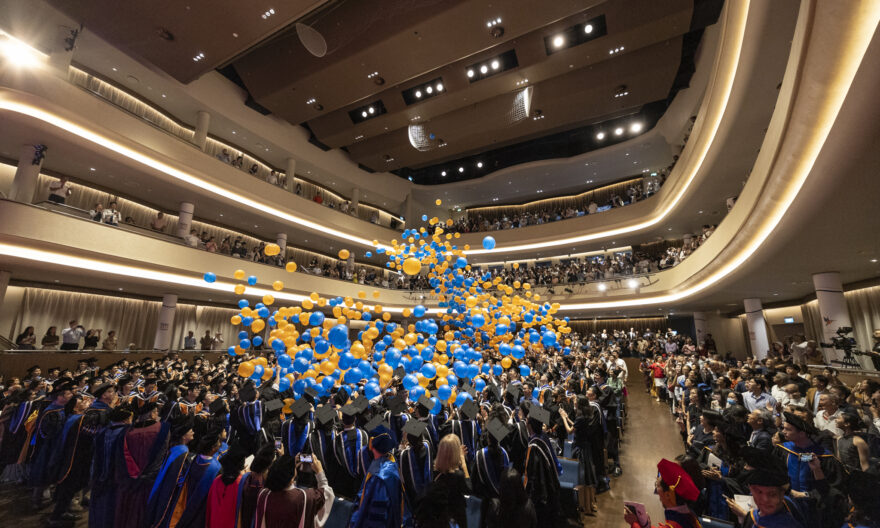Redefining Boundaries: Rector’s Teas and Art
Exploring unique life paths and the art of haiga with Koh Buck Song
A defining tradition at Yale-NUS, Rector’s Teas are a series of talks designed for the community, aiming to extend the learning experience beyond the confines of the classroom. This semester, the Teas revolve around the theme “Arts in Singapore”.
Rector and Associate Professor of Science (Life Sciences) Khoo Hoon Eng organised the first session in this series on 25 January, inviting award-winning poet and writer Koh Buck Song to speak with students and share his insights. The session was moderated by Director of Public Affairs Fiona Soh, who formerly worked with Buck Song at the Singapore Economic Development Board. The session focused on the intersection of literature and visual arts through Buck Song’s unique journey with haiga art as well as his career, spanning from country branding to political journalism and public service. The conversation then continued with a small group of students over dinner at Cendana Dining Hall.

Haiga was an art form that came into prominence in 17th century Japan, and consisted of a haiku poem accompanied by an image, which was usually drawn or painted by the poet. Buck Song first learned about it on a trip to Japan in 2015, and soon after, began to experiment with it. “Visual arts say a picture is worth a thousand words – but I like to flip this on its head and say with haiga, a word can evoke a thousand pictures,” said Buck Song.
Buck Song is not someone who is afraid to challenge conventions or try new things. He shared about the Blue Ocean Strategy – a book by two professors of strategy at INSEAD, Renée Mauborgne and W. Chan Kim – and its influence on his career and general approach to life. The book encouraged individuals to explore uncharted territories and develop unoccupied niches – in other words, creating demand in new market spaces rather than competing in existing ones. Haiga, a little practiced form of art that demanded proficiency in both writing and visual arts, was immediately appealing to him. Beyond this, country branding, which involves strategically shaping international perceptions of a nation in order to achieve beneficial goals such as attracting foreign spending, was another niche field that Buck Song worked in. His book, Brand Singapore – Nation Branding in a World Disrupted by Covid-19, emphasised the importance of multiculturalism and resilient social harmony to Singapore’s brand, adding that these held great value amidst rising cultural divisiveness across the globe. Similar to haiga art, only a small group of individuals worked in country branding, with 300 practitioners from around the world and Buck Song being the only one from Singapore.
Participants were intrigued by the ideas raised during the talk. Inspired by Buck Song’s Blue Ocean approach, one participant sought advice on maintaining conviction and confidence while adopting this approach, highlighting the universal struggles of breaking away from conventional paths. Another participant shared that she found it refreshing to hear a perspective different to that usually given by career advisors, and sought advice on implementing the ‘blue ocean’ mindset in her career.
“My biggest takeaway from today was that we can actually be very flexible in our lives, and it’s not taboo to have a professional reconversion later in our life! It’s really impressive that Koh Buck Song came from a very different field and ended up following his passion to create art,” said Dara Velikova, a visiting student from Sciences Po.
The conversation then turned to the future of the arts, with lively discussions held on the impact of technology and Artificial Intelligence on arts and writing spaces, as well as the potential for collaboration between painters and poets to create haiga. Buck Song emphasised the need for creative collaboration, and in discussing the future of haiga, expressed optimism about its potential reach through modern platforms such as mobile devices, as it could be easily shared with a wide audience.
Agimaa Otgonbaatar (Class of 2024) was inspired by the talk. “I’ve been recently interested in interdisciplinary art, and when I saw this talk, I was keen to learn more. I was pleasantly surprised to learn about his others roles as well, and understand the motivations and life philosophy behind his prolific career,” said Agimaa.
As the Rector’s Tea concluded, participants left with a richer understanding of Buck Song’s artistic journey and the broader implications of haiga in contemporary times. The upcoming session in March by Corrie Tan, a writer, performance practitioner and researcher, promises to continue this exploration of the intersections between literature and the visual arts, encouraging further dialogue about the evolving landscape of creative expression.





